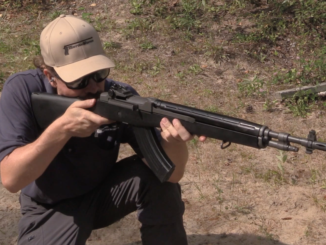While the MkII (1905) iteration of the Ross rifle had resolved most of the major mechanical problems form the MkI, it retained a number of characteristics that the Canadian (and British) military was not fond of. In particular, it was not suited to the use of stripper clips. Starting with experimentation on sporting rifles, Ross substantially redesigned the action for the final 1910 pattern – aka the MkIII.
The MkIII used a rotating bolt as before, but with six locking lugs in two rows of three, instead of two large lugs as the MkI and II. The magazine was replaced by a conventional single-stack design, with a stripper clip guide built into the receiver, and with a nicely adjustable rear aperture sight. This would be the model to equip the Canadian infantry who went to Europe to fight in 1914 and 1915 – and it is there that a new set of problems would begin to plague the Ross.
In keeping with its sporting legacy and reputation for outstanding accuracy, the MkIII Ross was made with a rather tight chamber, optimized for the excellent-quality Canadian production .303 ammunition. Britain had been forced to massively increase ammunition supply as the war lengthened, and British standards had widened to accept ammunition that was really of rather questionable quality. The SMLE rifles used by British forces had chambers made to accommodate this, but the Rosses did not. Canadian ammunition was supposed to follow the Canadian troops, but it was usually diverted to other services because of its high quality, and the Canadians left with ammo that was difficult to chamber or extract in the Ross.
This led to men having to beat open rifle bolts, which led to damage to locking lugs, in a viscous circle of escalating problems. By the time of the German gas attack at Ypres, Canadians were ditching their Rosses for Lee Infields by the thousands, despite specific orders to the contrary. General Haig finally had enough of the issues, and ordered the Ross removed from combat in 1916, to be replaced by the SMLE (which was finally available in sufficient numbers to arm the Canadian troops).




For further details on the Ross as a whole, and the personalities involved, I will refer you to C&Rsenal’s Primer video on the Ross, though it runs for over an hour. One of the other downfall-causes of the 1910 Ross parallels the Pattern 13 — it was originally designed for the .280 Ross cartridge, another round that was too powerful for the metallurgy of the time. Would the Mk III have fared better with two solid bolt lugs? If bolt stops were a problem on the Mk I wouldn’t they have rectified them by the Mk III?
Hello,
i have a little piece of family history to relate, pertaining to the Ross rifle…
My Grandfather on my Father’s side was a chemistry graduate just before WW1; he was conscripted/drafted/joined the Chemical Corps, the British answer to the Germans use of poison gas. He rose to the rank of Sergent and survived the war without a scratch. In the Second WW he joined the Local Defense Volunteers (LDV, Look, Duck and Vanish) later the Home Guard, as a Sergent. There was a war on, real guns were hard to come by. His unit received a consignment of Ross rifles… My Father says he stared at the boxes of Ross rifles, and cursed for 10 minutes solid, in several languages, without repeating himself, using words my Father had never heard before. Such was the bad reputation of the rifle.
It strikes me though, that they might have served the Home Guard very well in the event. With covers to keep them clean, they would have enabled the HG to engage the enemy at range, then do the LDV bit. No trench warfare in the back blocks of Manchester!
Hence my interest in all your Ross videos. Many thanks for the education, and illumination of a little piece of my family’s history.
It strikes me that nobody thought of simply making a bolt cover for the Ross just to keep mud out of the bolt track.
James:
I’m sure you are right. Kept clean and lightly oiled, Ross rifles would have been quite suitable for the Home Guard. I cannot see why they would not have worked well for the sort of uses the Home Guard had for them.
I highly recommend the C&Rsenal episode on the Ross as a companion to Ian’s series: https://youtu.be/2uGYSQ_-FJU
From deep memory I recall an ‘American Heritage’ article about Americans serving in the International Brigade in the Spanish Civil War. There was a bit about the multiple weapons they were issued, thought the Mosin-Nagant ended up as standard.
Seems at least a few Ross rifles found their way to Spain. I’d forgotten this, but there was a mention of men using rocks to knock the bolts open or closed. Ian’s mention of this (and C&Rsenal’s) stirred the memory back.
“(…)Seems at least a few Ross rifles found their way to Spain.(…)”
According to https://carbinesforcollectors.com/spanishcivilwar1.html
During early August 1936, Stalin approved delivery from existing stocks of Red Army stores of the following rifles of non Soviet origin with the proviso that they be checked and wiped for any marks which could identify as of Russian or Soviet property: 9,000 Winchester Model 1895 Muskets 7.62x54mmR, 6024 Gewehr 98 7.92mm, 3,202 MK.3 and Mk3* Enfields .303, 3658 M88/90 and M95 Mannlichers 8x50mmR, 10,000 French 11mm Gras Rifles, 1821 French M1878 Steyr Kropatchek 11mm Gras, 1242 French Lebel 8mm, 2310 Canadian M10 Ross .303, and 16,000 single shot M1871 Vetterli 10.4mm. Only a very limited amount of ammunition was provided for each rifle in the shipments and lack of ammo may have been the limiting factor in sending more of these nonstandard rifles to Spain. The Soviets had large numbers of these rifles and would issue them later during the emergency mobilization in June 1941.
I found interesting photo of Ross, see 1st photo from bottom
https://smallarms.ru/article?arms=ross
described as: members of Leningrad militia gets their weapon – Ross Mk. III
“(…)Britain had been forced to massively increase ammunition supply as the war lengthened(…)
“Artillery” part of this problem is today know as Shell Crisis of 1915 https://en.wikipedia.org/wiki/Shell_Crisis_of_1915
“(…)ammo that was difficult to chamber or extract(…)”
Interestingly according https://www.smallarmsreview.com/display.article.cfm?idarticles=4114 this was caused solely by loose quality control during Great War, but also design change (of ·303 British cartridge) made pre-war:
Every man wielded an Mk III Ross rifle, with some unease. Overseas, the gun had jammed in close combat during the Second Battle of Ypres. It was claimed the rifle was too finely made to tolerate mud and rough handling. There is truth to this, but the fatal flaw was a specific and avoidable mistake. Before the war, the British re-designed the .303 cartridge, rechambering their Lee-Enfields to a slightly larger size than the Ross. Canadian experts said the chamber of the Ross was already large enough to take the new British ammunition in a pinch, and the tighter fit could only increase accuracy anyway. The chambers were not reamed out. It was all about the money. Besides, the experts said, the men would have Canadian ammunition of the right size, so it hardly mattered.
When exactly did they apply that change? Would Ross M1910 work better with older ·303 British cartridges? Was it (back then) reasonable to assume that Canadian and British ammunition supply chain would never interfere?
The role that the Ross Rifle played in the political downfall of Sir Sam Hughes has often been exaggerated by people who focus on the history of the Ross Rifle. In actual fact Hughes was forced to resign because of conflict between himself and other senior cabinet figures over the management of the war effort and Hughes’s attempts to leverage more power and influence for himself.
A post on this forum does not allow enough space to go into all the aspects of a person as complex as Hughes, but he was already seen as a political liability before the war started. He had been accommodated up until then due to his political support among the Orangemen, but he had many political enemies who looked forward to his downfall.
He had more than a bit of megalomania about him, and he couldn’t stop interfering with the management of the Canadian army in Europe. His run-ins with others in this respect is what produced his final downfall and resignation from cabinet (although he remained in parliament as a back-bencher).
He had by the way apparently met Sir Charles Ross during the Boer War, when Hughes was serving in the Canadian army in South Africa. However, Hughes was not the one who decided on adopting the Ross Rifle. On the other hand, Hughes’s refusal to admit to problems with the Ross Rifle, as he refused to acknowledged many other problems in other areas, contributed to him shouldering much of the blame for its problems.
Interesting postscript on the MkIII Ross, at the 1956 Melbourne olympics, the USSR shooting team won gold in the full bore rapid, ‘Running Deer’ events using highly modified MkIII rifles chambered for 7.62 Russian (need to confirm the chambering, but definitely wasn’t 303!) it was also rumoured the USSR team members gifted their rifles to members of the Williamstown Rifle Club where the events were held in appreciation for organising the events.
I’ve seen some m95 Steyr rifles with bent back bolt handles, too.
The Ex-Canadian Corps Ross rifles would go on to serve with the Royal Navy and Marines from 1916 replacing a raft of miscellaneous rifles purchased in 1915. The Ross being in .303 and the issues in the trench’s not applying to sea going forces made it a better model than some of what was then in service. They would also be sent as aid to those forces fighting the Bolsheviks after 1917 to 1922/3 that where supported by the allies. It is probable that these where the rifles that ended up in Spain as Russian aid during the Spanish civil war. The miscellaneous rifles had been authorized by Churchill in early 1915 after he approved Naval Lee Enfield’s to be sent to the Army – who where expanding rapidly and lacked rifles, and also the newly formed Naval Division. These Lee Enfield’s where sourced from RN fleet units surrendering a proportion of their outfit of rifles. Rifles purchased such as Winchester model 92 & 94 in 30/30 & 44/40 and Remington model 14 1/2 in 44/40 as well as Japanese rifles in 6.5 mm – this model also went to Russia in 1916/17 after replacement by the Ross. I own a .44/40 Remington model 14 1/2 with Canadian Inspectors and the Broad Arrow marks (Canadian Inspectors placed in US factories). This rifle was issued to the Royal Naval Air Service for use from aircraft due to the poor load carrying ability of aircraft in combat in 1915. I also own a Ross M10 military style rifle that appears to be a civilian target model in .303 judging from the superb condition of the finish, the low serial number and lack of military markings. However I understand a number of rifles may have been assembled from left over parts in 1918 and this could also be an explanation.
One of my Grandfathers was drafted into the Canadian Army in the Great war. I was looking at his picture today where he is on horseback with a rifle and it dawned on me that it is not an Enfield. After years of this picture hanging on the wall of my parents den I just now realized it looks like a Ross. Crazy!